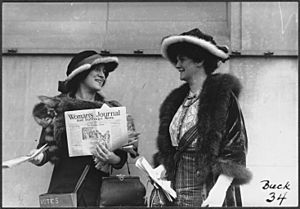Margaret Foley (suffragist) facts for kids
Quick facts for kids
Margaret Lillian Foley
|
|
|---|---|

Margaret Foley (right) and another suffragist distribute the Woman's Journal, 1913.
|
|
| Born | February 19, 1873 Boston, Massachusetts
|
| Died | June 14, 1957 (aged 82) Boston, Massachusetts
|
| Nationality | American |
| Other names | Maggie Foley |
| Known for | Suffragist, labor organizer |
Margaret Lillian Foley (born February 19, 1873 – died June 14, 1957) was an amazing American woman from Boston. She was a labor organizer, a suffragist, and a social worker.
Margaret was known for speaking up at political events. She would challenge candidates who did not support women's right to vote. Because of this, people called her the "Grand Heckler."
Contents
Early Life and Work
Margaret Foley was born in Boston, Massachusetts. Her parents were Peter and Mary Foley. She grew up with her sister, Celia, in Roxbury.
Margaret went to Girls' High School. She loved to sing and paid for voice lessons herself. She earned money working at a hat factory.
Later, she moved to California for a while. There, she taught swimming and gymnastics. When she came back to Boston, she returned to her old job.
Margaret became very active in the trade union movement. This movement helps workers get fair pay and good conditions. She even joined the board of the Boston Women's Trade Union League. She also became a strong supporter of women's right to vote.
Fighting for Women's Vote
Margaret Foley was one of the few Irish Catholic women in Boston who fought for women's suffrage. Suffrage means the right to vote. She was tall and confident. Her voice was strong and well-trained.
She was a very good public speaker. Margaret spoke to hundreds of groups. Often, she would speak up from the audience, which is how she got her nickname, "The Grand Heckler."
Margaret believed that if women could vote, they could make factories safer. They could also help stop corruption in the government. She worked for the Massachusetts Woman Suffrage Association (MWSA) from 1906 to 1915. She also joined other groups like the Margaret Brent Suffrage Guild.
Speaking Out in Public
In 1909, suffragists in Massachusetts started giving speeches outdoors. This was inspired by English suffragists like the Pankhursts. Many speakers were from wealthy families. They often felt uncomfortable speaking to factory workers.
Margaret was different. She was from a working-class family and was Irish Catholic. She had a lively personality. She often spoke to crowds of men, even in places like the Boston Stock Exchange. She would hand out leaflets about women's suffrage.
One time, to avoid being arrested, she spoke from the roof of a building. She called out to a speaker, asking why he voted against women's suffrage. Her voice was heard clearly above the crowd.
In her most famous moment, she debated Timothy Callahan. He was a speaker at a political club in Boston. Margaret, dressed stylishly, argued so well that the audience cheered for women's rights. They even threw their hats in the air!
In 1910, Margaret did something very bold. She flew alone in a hot air balloon over Lawrence, Massachusetts. From the basket, she dropped papers about women's suffrage.
Traveling for the Cause
In 1911, Margaret and Florence Luscomb went to an international suffrage meeting in Stockholm. They also spent a month in London. There, they learned new ways to fight for the vote from English suffragists.
That same year, Margaret used her car, called the "Big Suffragette Machine." She followed the Republican candidate for governor, Louis A. Frothingham. He was against women voting. She would challenge his views at his events. He even told his band to play music to stop her from speaking! He did not win the election.
Margaret started speaking all over the country in 1912. She traveled to Ohio, Nevada, New York, and Pennsylvania. In 1914, she spent two months in Nevada. She spoke to over 20,000 men there.
She even dressed like a miner once. Another time, she went 2,500 feet underground in Virginia City, Nevada to give a speech. Women in Nevada won the right to vote that year. In 1916, Margaret toured many Southern states.
Margaret was very successful as a speaker. However, she was an outsider among the wealthy women in the suffrage groups. She sometimes had disagreements about her pay and travel costs. Her working-class background helped her connect with crowds. But after World War I, the movement changed its focus. Margaret found it harder to find steady work.
Later Years and Legacy
In 1920, Margaret was appointed to a job in the Children's Institutions Department in Boston. She had been nominated by Mayor John F. Fitzgerald the year before.
She worked as a Trustee for Children from 1913 to 1920. Then, she became a deputy commissioner in the Child Welfare Division from 1920 to 1926.
Margaret lived for many years with her friend Helen Elizabeth Goodnow. Helen was also a suffragist. Margaret Foley passed away on June 14, 1957. She is remembered for her brave and powerful work for women's rights and workers' rights.

